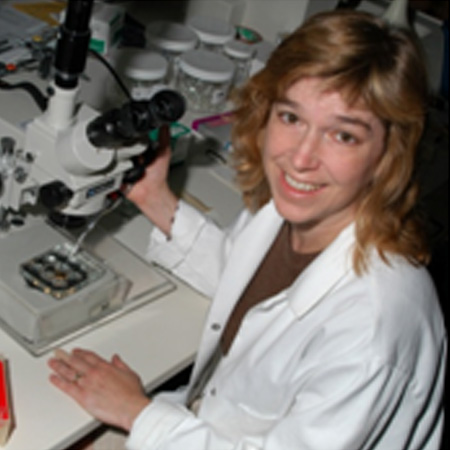
Professor of Biochemistry and Molecular Biology
Eppley Institute for Research in Cancer & Allied Diseases
University of Nebraska
USA

Eppley Institute for Research in Cancer & Allied Diseases
University of Nebraska
USA
| B.S.E-Biomedical Engineering | 1981 - 1985 | University of Iowa, USA |
| Ph. D-Biochemistry | 1986 - 1992 | University of Iowa, USA |
Dr. Gloria Borgstahl is from Dubuque, Iowa and graduated from Hempstead High School in 1981. She then went all the way to Iowa City for her degree in Biomedical Engineering in 1985 and Ph.D. in Biochemistry in 1992. During graduate school she learned protein X-ray crystallography with Dr. Arthur Arnone and was one of the first recipients of the NIH BioCATs doctoral fellowship. She moved to the San Diego area to learn time-resolved crystallography and other structural biology methods during a postdoctoral fellowship at The Scripps Research Institute. After a brief postdoctoral fellowship at Los Alamos National Laboratory she became an Assistant Professor of Chemistry at the University of Toledo. She developed an independent research program involving protein crystal quality, defense mechanisms against reactive oxygen species and in double-strand break repair. In 2002 she was happily recruited to Omaha, Nebraska where she continues these research programs at the Eppley Institute for Research in Cancer and Allied Diseases on the campus of the University of Nebraska Medical Center. She is also a courtesy faculty member in the Department of Biochemistry and Molecular Biology and the Department of Pharmaceutical Sciences; as well as, a member of the NCI-designated Fred & Pamela Buffet Cancer Center.
Dr. Borgstahl uses the tools of X-ray crystallography to "see" what biological macromolecules look like and to understand the molecular basis of the chemistry of life. Many avenues of research are under exploration, with an emphasis on DNA repair, cellular motility, and collaborations within the Cancer Center to directly visualize cancer-related macromolecules. For example, her research on homologous recombination-based double-stranded DNA break repair has focused on understanding the structural basis for HR and searching for therapeutics for breast, ovarian and pancreatic cancer based on the synthetic lethality of the RAD52 repair pathway with the BRCA1/BRCA2/PALB2 pathway. Specifically her research has concentrated on human Replication protein A (RPA), the ubiquitous, single-stranded DNA-binding protein and complexes formed with the DNA repair factors RAD51 and RAD52. This research has led to three different crystal structures of the full-length RPA heterodimer, composed of the RPA14 and RPA32 subunits, several biophysical publications on the RAD52:RPA complex, along with research on regulation by posttranslational modifications and ongoing screening efforts to inhibit the RAD52:RPA complex. The laboratory has also had a long-standing interest in oxidative damage, and has determined several structures to contribute to the understanding of the enzymatic mechanism of superoxide dismutases. Another project includes an innovative research program in cellular motility that will provide new tools to macromolecular crystallographers for structure determination from modulated crystals employing the four-dimensional superspace approach, and will also provide unique structural information for the actin filament. This work is supported by ACS, DHHS, NRI, NIH, NSF MCB, NSF CNIC and NASA.

All Sci Forschen Journals are Open Access